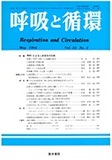Japanese
English
- 有料閲覧
- Abstract 文献概要
- 1ページ目 Look Inside
心室中隔欠損症(VSD)を代表とする肺血流増加群は,呼吸器感染に罹患しやすく,また気道狭窄や左心不全によって頻脈,呼吸窮迫そして呼吸性アシドーシスをきたすことがある1,2)。しかし,心拍数や呼吸が短絡量に及ぼす影響についての研究は少なく,Clairrnontら2)の気道狭窄時の報告と,著者ら3,4)の短絡作成犬を用いた報告があるのみである。これは心エコーやDoppler法が盛んになってきた今日でも,正確に連続的に直接短絡量を測定する方法がないためと思われる。
今回は心内短絡作成犬を用いて,心拍数および呼吸相の影響を検討し,さらに換気不全時に認められた短絡量増加のメカニズムを検討した。
The effects of heart rate and respiration on left to right ventricular shunt flow were studied in 23 dogs with a ventricular septal defect and normal pulmonary vascular bed. The interventricular shunt flow was mea-sured directly by using a specially designed electro-magnetic flow probe.
The change of heart rate by atrial pacing did not varied the left to right shunt flow, except in severe tachycardia (heart rate>200/min).
When left to right shunt flow was compared with respiratory phase, that was less in the inspiration than the expiration.
The increase of left to right shunt flow in hypoxia might be caused by the increase of cardiac output from left ventricle and the left ventricular end-diastolic pres-sure and volume. The third reason is the decrease of the pulmonary to systemic vascular resistance.

Copyright © 1986, Igaku-Shoin Ltd. All rights reserved.


